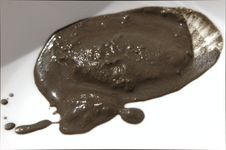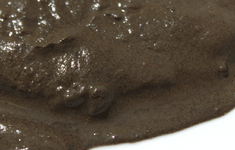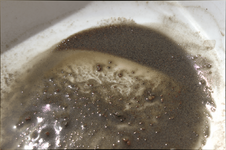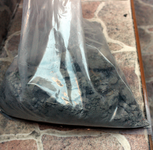Hi All.
I went to a mexican city where gold is produced at massive scale. And in one abandoned mine the watchman said he had a pile of mining waste of about 1 ton of weight. He said it has gold, he thinks I could get about 500 grams of gold out of the entire pile. He offered it to me for sale. I said "but how can I be sure it has gold?" and he answered: "go and take a sample, I know it has gold because I already checked, I just not after the money otherwise I could get it myself". He is very old (75 y/o) and looks like he knows what he is talking about and all of his family were miners, so I kind of believe him.
I took 3.5kg of this stuff, and tried to pan it at home, but I didn't find any gold. Well, I don't even know how gold looks like, it's only my second day of "gold rush". And I would like to ask you, does this clay looks like a matter that has any gold, observing the picture?
Here is a small portion of it before paning:


After that I tried to pan it but I could not find any gold. Probably because it was ground by mining machines so every piece of gold in it is very tiny , this is why I can't see it without microscope.
After shaking a lot and seeing what is on the bottom:


So what do you think? Does it look like clay with gold? And how would I get the gold out of it? What method should I use?
P.S.
btw, with different lighting (this picture was taken without direct sun light) and totally dry, the clay has totally different color:

I went to a mexican city where gold is produced at massive scale. And in one abandoned mine the watchman said he had a pile of mining waste of about 1 ton of weight. He said it has gold, he thinks I could get about 500 grams of gold out of the entire pile. He offered it to me for sale. I said "but how can I be sure it has gold?" and he answered: "go and take a sample, I know it has gold because I already checked, I just not after the money otherwise I could get it myself". He is very old (75 y/o) and looks like he knows what he is talking about and all of his family were miners, so I kind of believe him.
I took 3.5kg of this stuff, and tried to pan it at home, but I didn't find any gold. Well, I don't even know how gold looks like, it's only my second day of "gold rush". And I would like to ask you, does this clay looks like a matter that has any gold, observing the picture?
Here is a small portion of it before paning:


After that I tried to pan it but I could not find any gold. Probably because it was ground by mining machines so every piece of gold in it is very tiny , this is why I can't see it without microscope.
After shaking a lot and seeing what is on the bottom:


So what do you think? Does it look like clay with gold? And how would I get the gold out of it? What method should I use?
P.S.
btw, with different lighting (this picture was taken without direct sun light) and totally dry, the clay has totally different color:

Amazon Forum Fav 👍
Last edited:
Upvote
0


